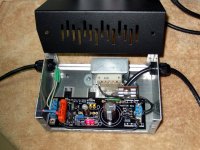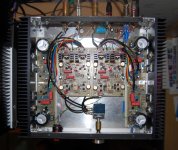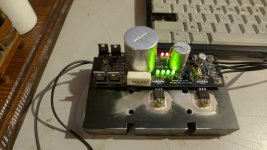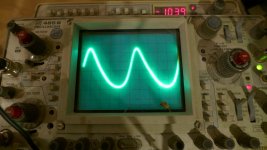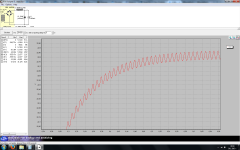in any case
be sure to follow the news
the effect should be of worldwide impact
according to my theory at least🙂
be sure to follow the news
the effect should be of worldwide impact
according to my theory at least🙂
HELLO, I go with this circuit. http://i194.photobucket.com/albums/z246/Ryssen_07/Sala-shunt-for-DAC.jpg
i no have enough 170 but, 117 plenty. which part should use 170 for best sonic? rest 117 🙂
i no have enough 170 but, 117 plenty. which part should use 170 for best sonic? rest 117 🙂
All can be 117. Maybe some change in the trim resistor values if its GR. Don't use the 0.1uF bypasses across the outputs.
Hi Salas I plan to house the transformer, rectifier, caps, and a version of your shunt regulator all in one chassis with an umbilical cable feeding my preamp in another chassis. Is there any limit on the length from the regulator to the load? I plan to take four wires to the pre amp so the sense circuit is accurate?
Why...
not place the Salas regulator in the preamp chassis, and leave the transformer/rectifier and smoothing caps in the other chassis? Even with remote sensing, it may be advantageous to have the regulator itself closer to the load. As long as the transformer and rectification is in the other chassis you will have kept the nosie sources away from the preamp circuitry.
Hi Salas I plan to house the transformer, rectifier, caps, and a version of your shunt regulator all in one chassis with an umbilical cable feeding my preamp in another chassis. Is there any limit on the length from the regulator to the load? I plan to take four wires to the pre amp so the sense circuit is accurate?
not place the Salas regulator in the preamp chassis, and leave the transformer/rectifier and smoothing caps in the other chassis? Even with remote sensing, it may be advantageous to have the regulator itself closer to the load. As long as the transformer and rectification is in the other chassis you will have kept the nosie sources away from the preamp circuitry.
Final smoothing must be in the amplifier chassis.
Regulators, if you want them to perform, must be next to the amplifiers, preferably with zero length connections.
If you want to add distance between the transformer and the amplifier, then the rectifier must be next to the transformer and the first stage smoothing must be next to the rectifier.
These two sets of rules determine your layout. No other compromises should be allowed to deviate from those two sets of rules.
Regulators, if you want them to perform, must be next to the amplifiers, preferably with zero length connections.
If you want to add distance between the transformer and the amplifier, then the rectifier must be next to the transformer and the first stage smoothing must be next to the rectifier.
These two sets of rules determine your layout. No other compromises should be allowed to deviate from those two sets of rules.
Hi Salas I plan to house the transformer, rectifier, caps, and a version of your shunt regulator all in one chassis with an umbilical cable feeding my preamp in another chassis. Is there any limit on the length from the regulator to the load? I plan to take four wires to the pre amp so the sense circuit is accurate?
Its decidedly more accurate than conventional two wire connections, but inductance in long sense cable runs can hinder reaction bandwidth and pick noise. So if just the reg is in the same box with the preamp its the better solution due to much shorter sense rail cable. Given there is space to have choice. I have used up to 1.5m four wire umbilical without oscillation but it wouldn't be my first choice if allowed.
Attachments
Salas reg & Erno borbely preamp
I have been using Salas original version regulator since 2010. The preamp itself is original kit EB 325 from Erno Borbely. I was very satisfied with the sound. When I was doing listening tests does not matter the blind test or not, it was allways my prefered preamp.
This year I decided to build up v1.2 version of the reg. I have made dual mono preamp, so 2x Salas modules for each channel. Current sources are 300 mA each, preamp channels are asking for some 80 mA each. Two transformers are in another box and since I am not using another source than CD player Audiolab 8200CD, I decided not to use the switch selector. The result of my work is on attached picture.
After listening test with the new regs it seems to be a bit better, esecially the sound is more full. The details and overall character of the sound it is still the same as with the previous Salas reg (not dual mono). I am very happy that I was able to finish this work with such a success. Thank you Salas for the great work you have done.
Ladislav
I have been using Salas original version regulator since 2010. The preamp itself is original kit EB 325 from Erno Borbely. I was very satisfied with the sound. When I was doing listening tests does not matter the blind test or not, it was allways my prefered preamp.
This year I decided to build up v1.2 version of the reg. I have made dual mono preamp, so 2x Salas modules for each channel. Current sources are 300 mA each, preamp channels are asking for some 80 mA each. Two transformers are in another box and since I am not using another source than CD player Audiolab 8200CD, I decided not to use the switch selector. The result of my work is on attached picture.
After listening test with the new regs it seems to be a bit better, esecially the sound is more full. The details and overall character of the sound it is still the same as with the previous Salas reg (not dual mono). I am very happy that I was able to finish this work with such a success. Thank you Salas for the great work you have done.
Ladislav
Attachments
I have been using Salas original version regulator since 2010. The preamp itself is original kit EB 325 from Erno Borbely. I was very satisfied with the sound. When I was doing listening tests does not matter the blind test or not, it was allways my prefered preamp.
This year I decided to build up v1.2 version of the reg. I have made dual mono preamp, so 2x Salas modules for each channel. Current sources are 300 mA each, preamp channels are asking for some 80 mA each. Two transformers are in another box and since I am not using another source than CD player Audiolab 8200CD, I decided not to use the switch selector. The result of my work is on attached picture.
After listening test with the new regs it seems to be a bit better, esecially the sound is more full. The details and overall character of the sound it is still the same as with the previous Salas reg (not dual mono). I am very happy that I was able to finish this work with such a success. Thank you Salas for the great work you have done.
Ladislav
Looking good. Congrats & Merry Christmas.
Ladislav did you used other regulators?
I did not try other regulators together with EB 3325 preamp. I was trying other regs in my previous projects e.g. Balzen from NP, or Dispre from PMA. I consider Salas + EB combination best. Even comparing to other commercial products this is really good choice.
I did not try other regulators together with EB 3325 preamp. I was trying other regs in my previous projects e.g. Balzen from NP, or Dispre from PMA. I consider Salas + EB combination best. Even comparing to other commercial products this is really good choice.
May I ask about subjective impresions Salas+ EB325 kit versus Dispre+ dedicated psu by PMA.
Hi Salas,
I wanted to say that the Reflektor-D makes the Buffalo III sound much better. I used a TI TPS7A4700 before and the reflektor is wider sounding, if that makes sense. The dac is the source for the main rig and for the diy whole house setup. Even at the end of the chain at the office speakers the sound is better. I installed a reflector-d in the SD Trans 32/384 also. Not as noticeable an improvement as with the Buffalo but still a better sound. Clean and open, percussive notes are very good. Bass is very good. Now to buy parts and build the quad SSLV1.1 for the legato. The better the source, the better the stereo! Thanks Salas and TB for this opportunity to hear much better audio and learn so much in the process. Happy new year!
I wanted to say that the Reflektor-D makes the Buffalo III sound much better. I used a TI TPS7A4700 before and the reflektor is wider sounding, if that makes sense. The dac is the source for the main rig and for the diy whole house setup. Even at the end of the chain at the office speakers the sound is better. I installed a reflector-d in the SD Trans 32/384 also. Not as noticeable an improvement as with the Buffalo but still a better sound. Clean and open, percussive notes are very good. Bass is very good. Now to buy parts and build the quad SSLV1.1 for the legato. The better the source, the better the stereo! Thanks Salas and TB for this opportunity to hear much better audio and learn so much in the process. Happy new year!
TPS7A4700 is industry's modern low noise best. I was aware of that chip and I had the TI evaluation board to measure and subjectively compare with the Ref-D proto prior to its GB release. I did not change anything on the Ref-D proto due to those comparisons as I grew confident I preferred the Ref-D. I did not mention anything though not to bias anyone subjectively before evaluating Ref-D on his own. I am glad you prefer it too. Thanks for your feedback, happy new year to you and to everybody!
Hi people,
I have a few questions regarding Salas Blb 1.1:
-I have to power digital circuits of a USB to I2S XMOS board. It has its own linear regulators. How am I supposed to terminate the regulator? No decoupling cap, zobel, LC filter? The consumptions are 200 and 400 mA. Currently I've put 47 uF Elna Silmic 2.
-Am I supposed to braid the 4 output wires together (for example a star quad) or make them two separate twisted pairs?
-BJT should be better for digital, while MOSFET for analog, right?
-What about the Vref kind? Is resistive the best for lower noise? I use 2 red LEDs and resistor. I considered my resistor is too small of a value and needs high capacitance to bypass. I currently use Elna Silmic2 220 uF there for the digital regs and 150 uF RIFA PEG on the analog reg.
-The DAC is a paralleled tda1543 x 16. It draws about 700 mA. Is it best for it to have a local decoupling cap or to rely on the remote sensing of the reg?
Many thanks!
I have a few questions regarding Salas Blb 1.1:
-I have to power digital circuits of a USB to I2S XMOS board. It has its own linear regulators. How am I supposed to terminate the regulator? No decoupling cap, zobel, LC filter? The consumptions are 200 and 400 mA. Currently I've put 47 uF Elna Silmic 2.
-Am I supposed to braid the 4 output wires together (for example a star quad) or make them two separate twisted pairs?
-BJT should be better for digital, while MOSFET for analog, right?
-What about the Vref kind? Is resistive the best for lower noise? I use 2 red LEDs and resistor. I considered my resistor is too small of a value and needs high capacitance to bypass. I currently use Elna Silmic2 220 uF there for the digital regs and 150 uF RIFA PEG on the analog reg.
-The DAC is a paralleled tda1543 x 16. It draws about 700 mA. Is it best for it to have a local decoupling cap or to rely on the remote sensing of the reg?
Many thanks!
you must twist the sensor wires, otherwise interference on the LOOP will change what the sensor reads and you end up with an error in the correction voltage.
It is better to twist the output wires to prevent interference attacking them as well. Twisting also minimises the inductance (and increases the capacitance) of the output pair. This decreases the output impedance as seen by the circuit you are feeding.
In my view "braided" is a high inductance cable and should never be used.
It is better to twist the output wires to prevent interference attacking them as well. Twisting also minimises the inductance (and increases the capacitance) of the output pair. This decreases the output impedance as seen by the circuit you are feeding.
In my view "braided" is a high inductance cable and should never be used.
Hi people,
I have a few questions regarding Salas Blb 1.1:
-I have to power digital circuits of a USB to I2S XMOS board. It has its own linear regulators. How am I supposed to terminate the regulator? No decoupling cap, zobel, LC filter? The consumptions are 200 and 400 mA. Currently I've put 47 uF Elna Silmic 2.
-Am I supposed to braid the 4 output wires together (for example a star quad) or make them two separate twisted pairs?
-BJT should be better for digital, while MOSFET for analog, right?
-What about the Vref kind? Is resistive the best for lower noise? I use 2 red LEDs and resistor. I considered my resistor is too small of a value and needs high capacitance to bypass. I currently use Elna Silmic2 220 uF there for the digital regs and 150 uF RIFA PEG on the analog reg.
-The DAC is a paralleled tda1543 x 16. It draws about 700 mA. Is it best for it to have a local decoupling cap or to rely on the remote sensing of the reg?
Many thanks!
For the wiring, as Andrew said.
47uF termination is usually good on digital lines. Mosfet is also good down to 5V, preference to BJT or not its something you better evaluate on your own application. Not difficult to modify for both. Just a different value gate/base resistor and another type output device.
You can use up to 1000uF for the digital reg if you want to evaluate how sensitive your app is to VLF noise further filtering. If it will react detectably for subjective differences so to speak.
Last question only an oscilloscope can surely answer.
Thanks! Although question 1 about the board with the existing regs doesn't remain clear to me.
Some pics of working 8,5V/0,95A positive board with no oscillations. Choke input power supply. The scope photo shows the ripple on the first capacitor, after the choke.
The board is made of:
C101 - Kemet 2200 uF
C102 - Rifa PEG 150uF
C104 - Elna silmic 2 47 uF
SK117 with Ids between 8 and 12mA
Philips and Draloric NOS MF resistors
R1 cheap wirewound (to upgrade soon)
diode bridge not very hi-fi for now - P600M
Some pics of working 8,5V/0,95A positive board with no oscillations. Choke input power supply. The scope photo shows the ripple on the first capacitor, after the choke.
The board is made of:
C101 - Kemet 2200 uF
C102 - Rifa PEG 150uF
C104 - Elna silmic 2 47 uF
SK117 with Ids between 8 and 12mA
Philips and Draloric NOS MF resistors
R1 cheap wirewound (to upgrade soon)
diode bridge not very hi-fi for now - P600M
Attachments
- Status
- Not open for further replies.
- Home
- Amplifiers
- Power Supplies
- The simplistic Salas low voltage shunt regulator
